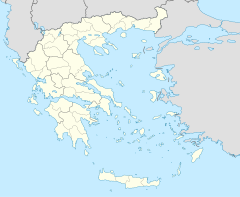Hekatompedon temple
| Hekatompedon | |
|---|---|

Sculpture from the east pediment depicting a lion killing a calf
|
|
|
Location within Greece
|
|
| General information | |
| Type | Temple for the worship of Athena |
| Architectural style | Ancient Greek Archaic |
| Location | Athens, Greece |
| Coordinates | 37°58′17″N 23°43′36″E / 37.9715°N 23.7267°ECoordinates: 37°58′17″N 23°43′36″E / 37.9715°N 23.7267°E |
| Current tenants | Museum |
| Construction started | ca. 570 BC |
| Completed | ca. 550 BC |
| Destroyed | 490 BC (Persian Wars) |
| Owner | Greek government |
| Design and construction | |
| Architect | unknown |
The Hekatompedon or Hekatompedos (Ancient Greek: ἑκατόμπεδος, from ἑκατόν, "hundred", and πούς, "foot"), also known as Ur-Parthenon and H–Architecture, was an ancient Greek temple on the Acropolis of Athens built from limestone in the Archaic period, and was placed in the position of the present Parthenon.
The name of the temple was found in inscriptions and means “100 feet long” (ca. 30 m), although its length reached 46 m.
The temple was built around 570–550 BC. It was demolished by the Athenians in 490 BC after the victory over the Persians at Marathon to build a larger temple known as the Older Parthenon. The latter was destroyed in 480 BC by the returning Persians and finally replaced by the present Parthenon. The existence of the Hekatompedon is witnessed by historical documents. Its foundations have disappeared, but architectural and sculptural elements found in the southern part of the Mycenaean wall of Acropolis have been assigned by scholars to this temple.
The surviving architectural elements indicate that the length of its crepidoma was probably ca. 46 m, that the temple was peripteral and of doric order.
One of the pediments (perhaps the West pediment) contained two lions tearing apart a bull in the centre, Herakles fights against Triton on the left and the Three-Bodied (Triple-Bodied) Daemon with the symbols of the three elements of nature in his hands on the right. The three elements are conserved in the Acropolis Museum of Athens and had been, until recently, misassigned to the close Temple of Athena Polias. The three bodies of the winged monster hold a wave, a flame and a bird and have intertwined snake tails, symbolizing the four natural elements, i.e. water, fire, air and earth, respectively. It represents either Nereus or Typhon. Overall the meaning of the whole pediment is mysterious. Some scholars believe that it means the dominance of the human wisdom over humidity: the lions are earth animals, whereas the bull represent humidity. In addition, both Triton and Nereus were sea creatures defeated by Herakles on its way to the Hesperides garden, which earned him immortality.
...
Wikipedia

